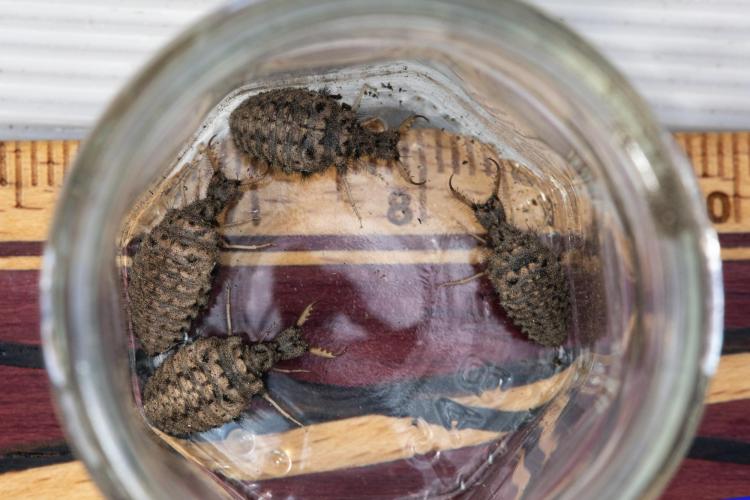Engineers of the mysterious pit traps
They are secretive and cryptic, but you can see them if you know what to look for
What causes those conical divots in the soft, dry soil beneath large conifers in the mountains and at the bases of cliffs on the Colorado Plateau? They presented a mystery when I first noticed them, for it was evident that something must be both constructing and maintaining them. Otherwise, breezes and gusts would soon fill them with sand, dust and forest litter. Yet they seem to be empty and unattended.

Top of page: Adult Antlion Above: Antlion larvae dig pit traps in the duff beneath large ponderosa pines. Photos by Jeff Mitton.
Antlion larvae are the denizens of the pits. They are secretive and cryptic, but you can see them if you know what to look for. They are often just beneath the sand at the base of the trap, but occasionally they wait with their heads and curved mandibles exposed. But you must look closely, for a larva is only about a half inch in length and the head and mandibles are about a third of that length.
The larva is grotesque, with large, curved mandibles bearing sharp spines, a flattened head on a flexible neck, six legs and a hairy body that tapers to the rear. It rarely walks on the surface, but it effectively swims backward through soft soil, rowing with its legs and sculling with its tail. The hairs on all parts of its body point forward, so they fold down neatly against the body when the legs push it backward, but become erect and embedded, effectively anchoring the larva when the legs return for another push, or when an animal tries to pull it out of the soil.
When a larva is searching for an appropriate spot to dig a pit trap, it wanders about, moving just beneath the surface. It needs a spot that is shaded in the afternoon, because afternoon soil surface temperatures can be lethal. It also needs to be protected from the rain because the walls of the pit must be dry to work effectively — ants can easily walk out of a trap on firm, moist soil. The larva's path during this search wanders, wiggles and circles, and the path, evident as a shallow trench, looks like something has doodled in the sand. Consequently, some people call them doodlebugs.
When a larva finds a suitable spot, it begins to move in a circle with a diameter of about one inch, using its head as a scoop to toss sand or dust outside the circle. It continues, in ever tightening circles, moving and tossing, forming a conical pit with steep walls. Depending on the size of the soil particles, the sides of the pit will form a "natural slope" which is the maximum angle at which the soil is stable. This is analogous to the perfect cone that forms when sand falls through an hourglass--the sand accumulates and slides until it finds the natural slope. When the pit walls have attained the natural slope, the larva buries itself at the bottom of the pit and waits.

Antlion larvae dig pit traps in the duff beneath large ponderosa pines. Photo by Jeff Mitton.
Sooner or later, a foraging ant (or beetle, spider, or pill bug) will wander into the pit and its weight will cause the sand beneath its feet to slide. Naturally, it would attempt to climb out, causing the sand to slide even more. The larva reacts by flicking sand up onto the struggling animal, slowing the struggler and increasing the amount of sliding sand. If the ant slides to the bottom, the antlion's jaws close, piercing the ant and injecting a venom through its hollow jaws. The venom contains bacterial compounds that paralyze, digest and dissolve the prey's tissues, which are then sucked through the hollow jaws. When the animal has been drained, the larva flicks the carcass up and out of the pit. Trapping and consumption of an ant takes about an hour.
Antlion larvae live two to three years, depending on species and environment."
Antlion larvae live two to three years, depending on species and environment. Adults, which have four wings and wingspans of three to four inches, eat nectar and pollen and live just a few weeks.
Antlion traps can be found in the bare dry soil beneath large ponderosa pines and Douglas-firs in the foothills around Boulder — dozens may be found beneath a single tree. In canyon country, look at the base of walls and cliffs. When you have located pit traps, you can search for the antlions with a magnifying glass, looking for the characteristic shape of the curved jaws. An antlion larva can be provoked to flick sand by touching the side of the pit with a fine piece of straw, causing sand to slide. To get a better look, thrust a trowel beside and beneath a pit and place the soil into a sieve or aquarium net, then search through the soil for the larva. It will be cryptic, for the hairs hold much sand. Finally, return the larva to soft soil and watch it bury itself.
This article is part of Jeff Mitton's ongoing blog, Natural Selections.

